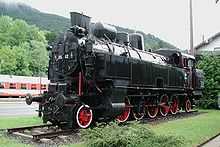Giesl ejector


A Giesl ejector is a suction draught system for steam locomotives that works on the same principle as a feedwater pump. This ejector (German: Ejektor, Flachschornstein or Quetschesse) was invented in 1951 by the Austrian engineer, Dr. Adolph Giesl-Gieslingen. The Giesl ejector ensures improved suction draught and a correspondingly better use of energy. The existing blastpipe in a locomotive is replaced by several, small, fan-shaped, diverging blast pipes, from which the diffuser gets its flat, long, drawn-out shape.
Fuel savings
Giesl claimed that his ejector enabled a saving in coal of between 6 and 12% – although in practice the maximum saving was more like 8% – and an increase in power of up to 20%. Many railway administrations converted their steam engines to Giesl ejectors, including the ÖBB, ČSD and Deutsche Reichsbahn (DR) in East Germany, as well as railway companies in Africa, China and Japan. The licence fees were not paid in every case, it being said that often they almost cancelled out the saving in coal. In the DR it was assessed that the Giesl ejectors would pay for themselves within a year, as a result of which they converted over 500 locomotives; primarily the Classes 38.10, 50, 52 and 65.10.
Use in the United Kingdom

Talyllyn Railway
In 1958, Dr Giesl-Gieslingen approached British Railways to offer a free trial of the ejector. When this offer was turned down, the inventor made the same offer to the preserved Talyllyn Railway in Wales, and locomotive No. 4, Edward Thomas was fitted with one.[1] Although a coal saving of 40% was officially announced at the time, this has since been disputed by the railway's chief engineer.[2] The ejector was removed in 1969, and no difference in coal consumption was found.[3] The ejector is now on display in the Narrow Gauge Railway Museum at Tywyn.
British Railways
In 1962, Bulleid Battle of Britain class 4-6-2 34064 Fighter Command was fitted with a Giesl ejector on the grounds that a desired spark arrestor would "suffocate" an ordinary blastpipe. It quickly became apparent, following some adjustment, that the ejector improved the locomotive design, and it was held in high regard by the crews.[4] A BR Standard Class 9F 2-10-0 92250 was also fitted with a Giesl ejector, but with "indifferent" results.[5]
Keighley and Worth Valley Railway
As a consequence of the experience with Fighter Command, and for the same reasons, during the 1980s the preserved Bulleid West Country class 4-6-2 34092 City of Wells was similarly fitted at the Keighley and Worth Valley Railway.
Australian Railways
New South Wales Government Railways
NSWGR only had one locomotive in its entire fleet which was fitted with a Giesl Ejector. The locomotive being 3616, a member of the NSWGR C36 class 4-6-0. In 1957, 3616 was fitted with a Giesl ejector along with its new Belpaire boiler. 3616, has made it into preservation. In the ownership of the New South Wales Rail Transport Museum located at Thirlmere, the locomotive is a static exhibit in the Thirlmere Train Hall.
In fiction
In the fictional narrow gauge railway by the Rev. W. Awdry based on the Talyllyn Railway, the locomotive Peter Sam, based on Edward Thomas, also received a Giesl ejector. Unlike Edward Thomas, Peter Sam retains the ejector to the present day.
References
- ↑ Potter, D. (1990). The Talyllyn Railway. David St John Thomas. p. 198. ISBN 0-946537-50-X.
- ↑ Bate, J.H.L. (2001). The Chronicles of Pendre Sidings. RailRomances. p. 81. ISBN 1-900622-05-X.
- ↑ Bate, page 153
- ↑ http://www.svsfilm.com/nineelms/giesl.htm
- ↑ http://www.srpsmuseum.org.uk/giesl.htm
External links
| Wikimedia Commons has media related to Giesl ejectors. |
- www.eisenbahnfotograf.de - Numerous photos of steam locomotives with Giesl ejectors (German)
- There is a relevant English-language forum at Railways of Germany
| ||||||||